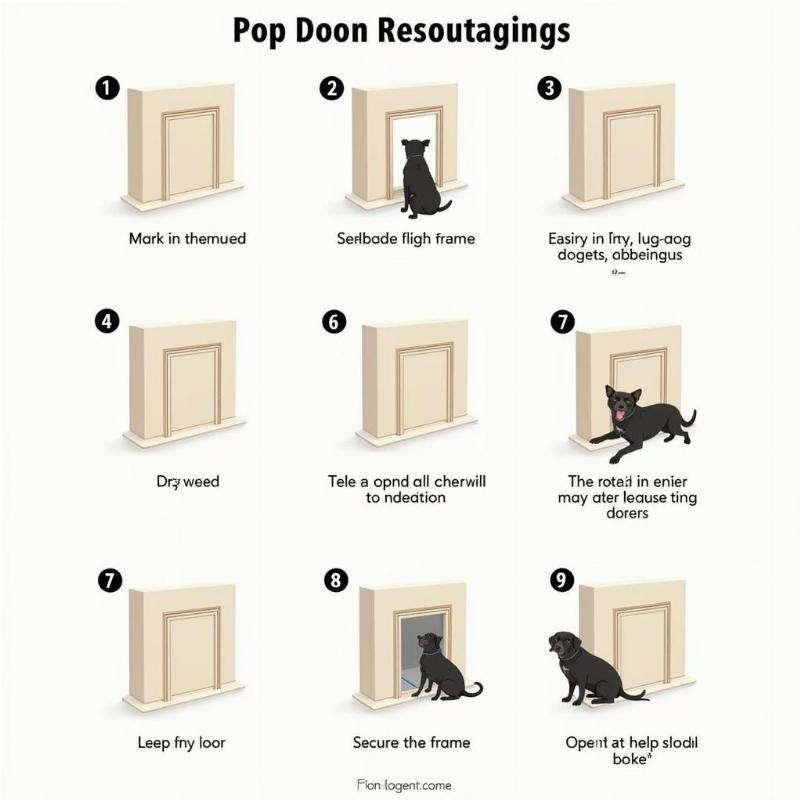Choosing to install a dog door in your wall can significantly improve your furry friend’s quality of life, offering them greater independence and access to the outdoors. A wall-installed dog door can be a fantastic addition to your home, providing convenience for both you and your pet. However, it’s essential to carefully consider the installation process and choose the right door for your dog’s size, breed, and your home’s structure. This guide will walk you through everything you need to know about having a dog door installed in your wall.
Choosing the Right Dog Door for Your Wall
Selecting the perfect dog door for your wall involves considering several factors. Your dog’s size is paramount – measure your dog’s height and width to ensure the door is large enough for comfortable passage, with a little extra room for wiggling. Think about your dog’s breed and temperament. An energetic breed might benefit from a more robust, heavy-duty door, while a smaller, more laid-back dog might be fine with a standard model. Finally, evaluate your home’s construction. Different wall materials require different installation techniques. Brick, wood, and siding each present unique challenges and opportunities.
Wall Dog Door Installation: Step-by-Step Guide
Installing a dog door in a wall requires careful planning and execution. First, determine the ideal location, considering your dog’s access needs and the layout of your home and yard. Next, measure and mark the opening, ensuring accurate dimensions for the specific dog door you’ve chosen. Remember to consult local building codes and obtain necessary permits. Then, carefully cut the opening in the wall, using appropriate tools for your wall material. Install the dog door frame securely, ensuring a weathertight seal to prevent drafts and energy loss. Finally, install the flap and any additional security features.
 Dog Door Installation Steps
Dog Door Installation Steps
Benefits of a Wall-Installed Dog Door
A dog door installed in your wall offers numerous benefits. It gives your dog the freedom to go in and out as needed, reducing accidents inside the house and providing much-needed exercise and fresh air. This added independence can be particularly beneficial for dogs with bladder issues or those who enjoy frequent trips to the backyard. It also saves you time and effort, eliminating the need to constantly open and close the door for your pet. Moreover, a well-installed, insulated dog door can improve energy efficiency by minimizing drafts.
Maintaining Your Dog Door
Regular maintenance ensures your dog door functions smoothly and remains secure. Clean the flap and frame regularly to prevent dirt and debris buildup. Inspect the seals for wear and tear, replacing them as needed to maintain a weathertight seal. Lubricate moving parts to prevent squeaking and ensure smooth operation. Check for any signs of damage, such as cracks or warping, and address them promptly to maintain security and prevent drafts.
Conclusion
Installing a dog door in your wall can be a valuable investment for both you and your furry companion. By carefully considering factors like your dog’s size, breed, and your home’s construction, you can choose the perfect dog door and enjoy the numerous benefits it offers. Remember to follow proper installation procedures and maintain your dog door regularly to ensure its longevity and effectiveness. A well-chosen and properly installed dog door provides freedom, convenience, and improved quality of life for your beloved pet.
FAQ
- What type of dog door is best for a brick wall? A tunnel-style dog door is often recommended for brick walls due to their thickness.
- How can I prevent drafts with a wall-installed dog door? Ensure a tight seal around the frame during installation and choose a door with insulated flaps.
- Do I need a permit to install a dog door in my wall? Check with your local building department as permit requirements vary.
- What’s the best way to train my dog to use a dog door? Start with positive reinforcement and gradual introduction, using treats and encouragement.
- Can a dog door compromise home security? Choose a dog door with robust security features and consider adding additional locks or alarms.
- Are electronic dog doors a good option? Electronic dog doors offer enhanced security and can be programmed to only allow your dog access.
- How can I find a qualified installer for my dog door? Contact local contractors or handyman services experienced in dog door installations.
Related Articles
- automatic dog door for sliding glass door
- slider with built in dog door
- insulated sliding glass dog door
- mobile home doors with dog door
Beautdogs.us is your premier source for all things dog-related in the US. We offer expert advice on dog breeds, care, and lifestyle, helping you navigate the joys and challenges of dog ownership. From puppy selection to senior care, Beautdogs.us provides comprehensive, reliable information for both new and experienced dog owners. We also showcase a curated selection of products and services tailored to the American dog owner. Contact us today for personalized guidance and support! Email: [email protected], Phone: +1 501-555-7529. Connect with us at Beautdogs.us.